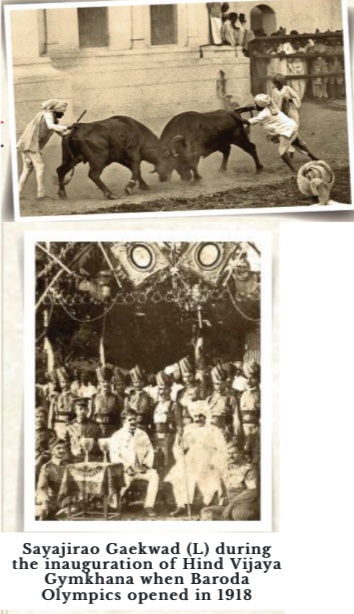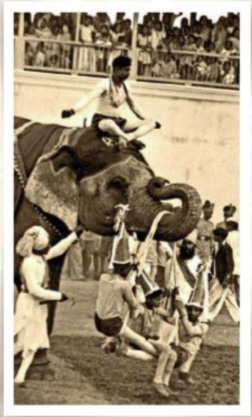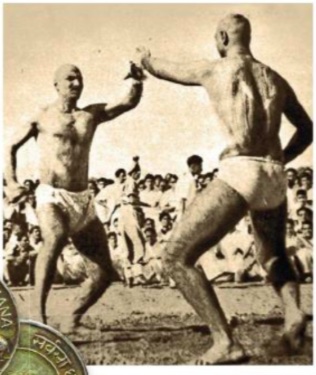Baroda
This article has been extracted from THE IMPERIAL GAZETTEER OF INDIA , 1908. OXFORD, AT THE CLARENDON PRESS. |
Note: National, provincial and district boundaries have changed considerably since 1908. Typically, old states, ‘divisions’ and districts have been broken into smaller units, units, and many tahsils upgraded to districts.Many units have since been renamed. Therefore, this article is being posted mainly for its historical value.
Baroda
Village in the Gohana tahsil of Rohtak District, Punjab. See Barauda.
Sports
The Baroda Olympics, 1918
Oct 12, 2022: The Times of India

From: Oct 12, 2022: The Times of India

From: Oct 12, 2022: The Times of India
[[File: “Winners were given gold, silver and bronze medals engraved with the Baroda state’s symbol of two elephants and the five interlocking rings of the Olympics.”- Baroda.jpg“Winners were given gold, silver and bronze medals engraved with the Baroda state’s symbol of two elephants and the five interlocking rings of the Olympics.”- Baroda|
From: Oct 12, 2022: The Times of India|frame|500px]]

From: Oct 12, 2022: The Times of India
Just as the 36th National Games in Gujarat have given Indian sportspersons a platform to show their talent after two long Covid years, a century ago the Baroda principality in the state started its own annual ‘Olympics’ to nurture Indian sports. “The sports festival was called the Royal Baroda Gaekwad Olympics (RBGO),” says Jitendrasinh Gaekwad, great-grandnephew of the games’ founder, Maharaja Sayajirao III. “Sayajirao wanted youngsters to participate in games and stay physically fit and active. He had instilled this habit in his own sons too. To bring sportspersons to a common platform, he started organising the annual sports meet. ”
The maharaja had attended the very first modern Olympics in 1896, says art historian Chandrashekhar Patil, who has organised several photo and painting exhibitions on Sayajirao. “The grand celebration of sports and its organisation at the international level had impressed him. He decided to replicate the model in Baroda. ” And so, the first edition of the Baroda Olympics was held in 1918 at the Hind Vijaya Gymkhana.
The state had a separate budget forthe games that covered athletics, wrestling, cycling, gymnastics, kabaddi, mal-khamb, horse riding, military sports, bodybuilding, and other disciplines. The preliminary rounds were held across the erstwhile Baroda state – at Navsari, Mehsana, Dwarka, Amreli – every winter, and the finals were held at the Hind Vijaya Gymkhana in Baroda town. Sayajirao would preside over the awards ceremony.
“Winners were given gold, silver and bronze medals engraved with the Baroda state’s symbol of two elephants andthe five interlocking rings of the Olympics,” Patil told TOI.
The games drew sportspersons from Britain, Austria, African countries, the US, Iran, Afghanistan, Russia and many other countries. Sayajirao was known to pick the best Indian players in several fields, and offer jobs to them so they could settle in the state.
The games continued even after Sayajirao’s passing in 1939, but they were stopped in 1951 after India became a republic and the government started organising sports tournaments.
There were blood sports too
Few inhabitants of Vadodara’s denselypopulated Bhadra locality near Mandvi Gate know that the land they live on was once the scene of animal fights and gladiatorial contests.
The Bhaskarrao Aggad (battle arena) near Bhadra Kacheri, only a part of which remains, was like the Roman Colosseum. Although local history buffs believe it was built in the time of Sultan Mahmud Begada (died 1511), art historian Chandrashekhar Patil says it was properly built during the Gaekwad rule.
The aggad covered 3 acres and had different sections for elephant fights, boar fights, bird fights and wrestling. Kings, members of royal families and other important people watched the fights from a high gallery in the wood-andstone theatre, while commoners sat or stood on the 3-metre-wide stone parapets around the aggad. Spectators cheered every time combatants’ blood was spilled. Jitendrasinh Gaekwad, the great-grandnephew of Sayajirao III, says men fought tigers, lions and cheetahs under the Mughals, but fights with carnivorous animals were stopped in the Maratha period. However, fights involving elephants, bulls, rhinos and wild boars continued. There were also fights between horsemen. The participating animals Join the Times Special Readers’ Club. Scan the QR code toand birds were intoxicated with liquor or opium.
Fights with intoxicated elephants were called ‘saathmaari’ as the combatant had to fight the elephant for 60 minutes. It was one of the most dangerous sports and led to the closing of the aggad, says Dr Damodar Nene, who has written a biography of Sayajirao Gaekwad III and witnessed the last fight at the aggad. He had told TOI earlier that the aggad was closed in 1949 after a man was trampled by an intoxicated elephant.